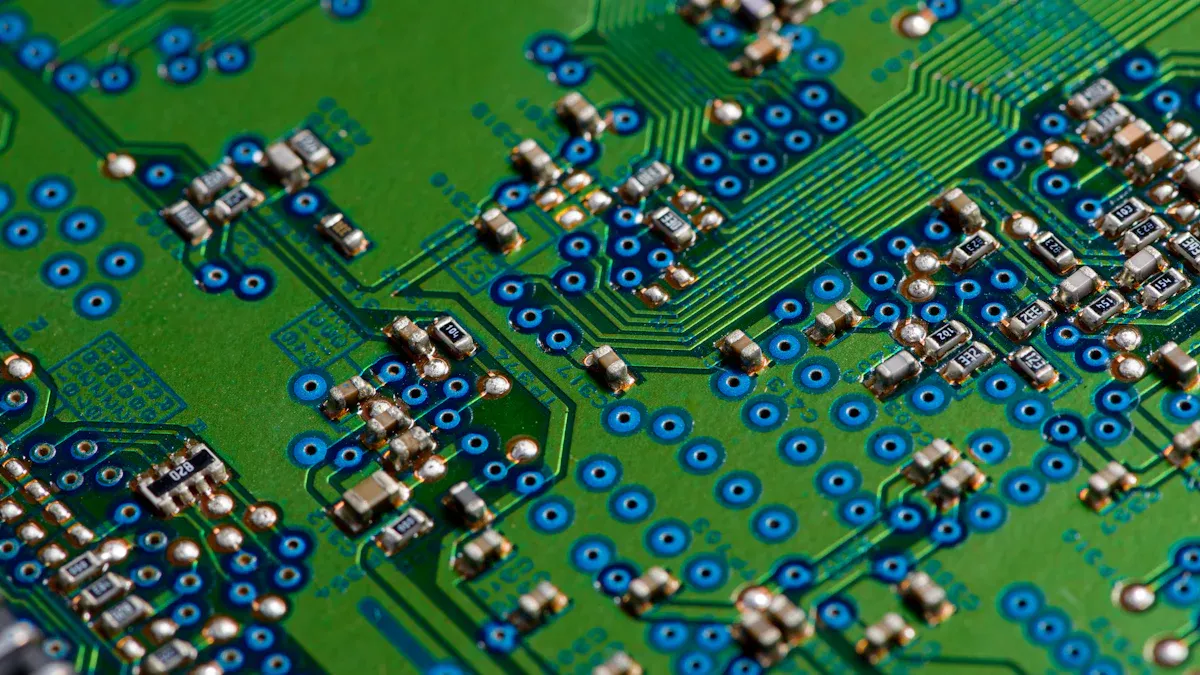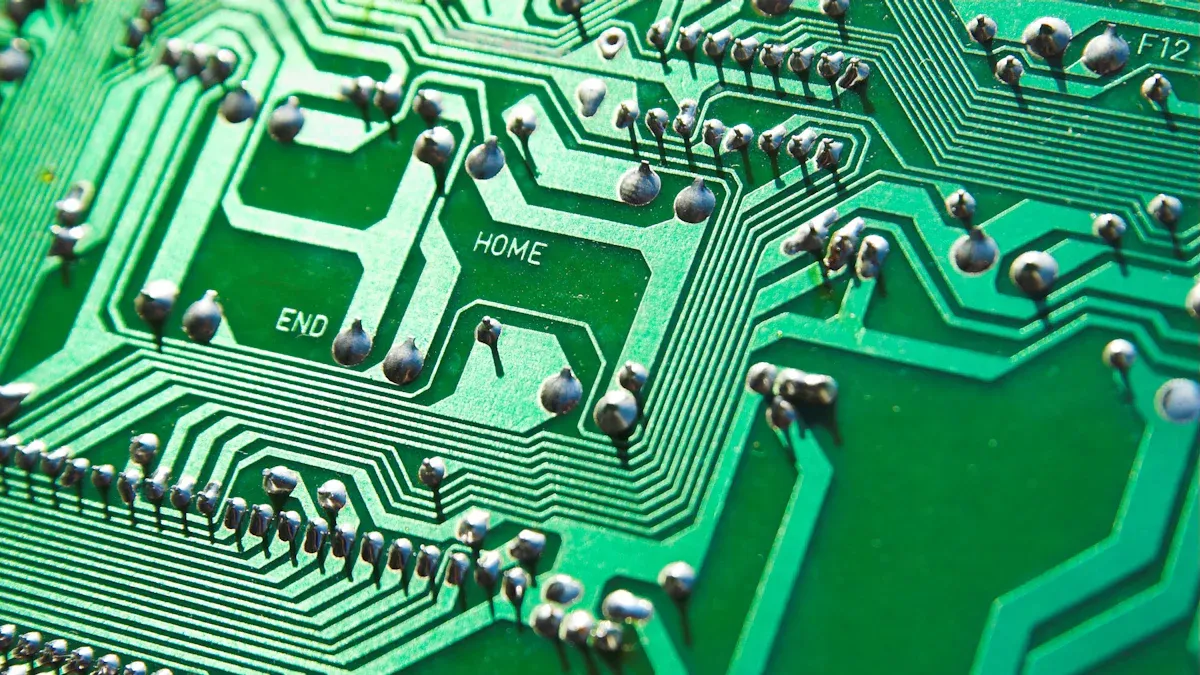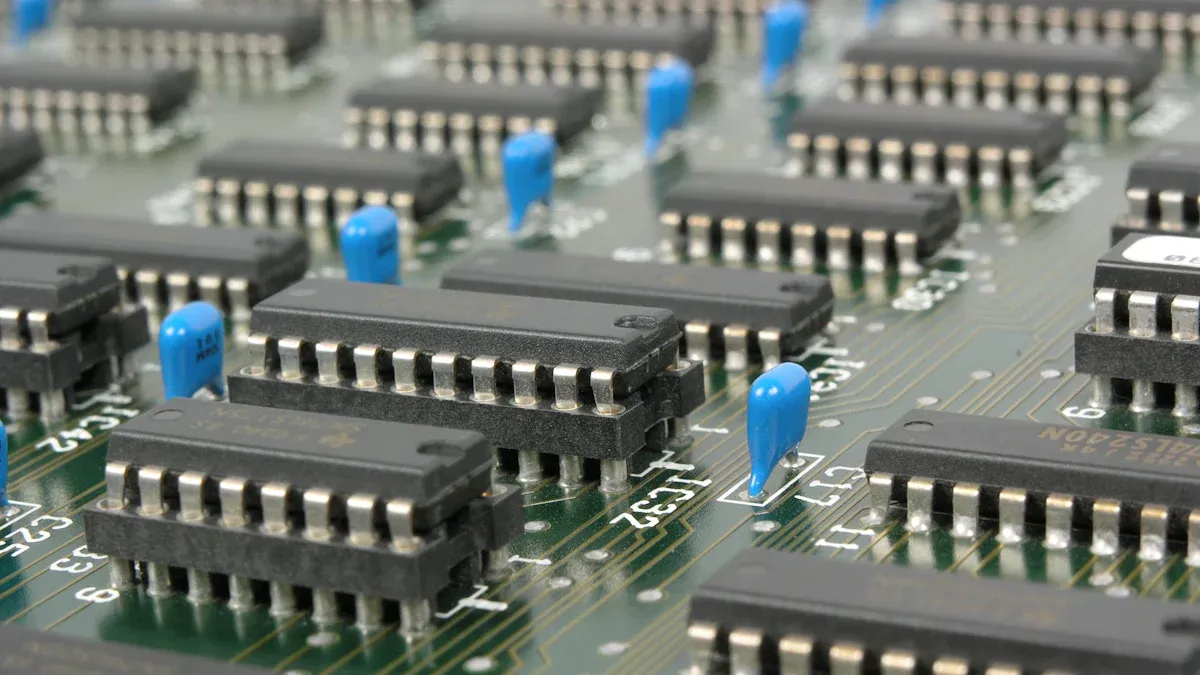Understanding Logic IC Bus Transceivers in Electronics

A Logic IC Bus Transceiver helps you transfer data between two electronic buses. It works bidirectionally, enabling signals to move in both directions. This functionality makes it vital for systems requiring smooth communication between different parts. You’ll find these components in many modern devices because they improve data flow efficiency. By controlling signal direction, they ensure that information moves accurately without interference, even in complex circuits.
Key Takeaways
Logic IC Bus Transceivers help send and receive data both ways.
Pick the right transceiver type, like inverting or non-inverting, for your circuit.
Tri-state transceivers stop signal clashes by using a high-impedance state.
This lets many devices use the same bus without problems.
Knowing how to control signal direction helps data move correctly.
Use Logic IC Bus Transceivers in things like HVAC systems or factories.
They make systems work better and more reliably.
Types of Logic IC Bus Transceivers

Understanding the types of Logic IC Bus Transceivers helps you choose the right component for your electronic designs. Each type serves a specific purpose, making it essential to know their differences.
Inverting and Non-inverting Transceivers
Inverting transceivers reverse the logic state of the signal during transmission. For example, a high signal becomes low, and a low signal becomes high. These transceivers are useful when your circuit requires inverted logic for proper operation.
Non-inverting transceivers, on the other hand, maintain the original logic state of the signal. They ensure that the data remains unchanged as it moves between buses. You might use these transceivers when preserving signal integrity is critical.
Tip: If your design involves mixed logic levels, combining inverting and non-inverting transceivers can simplify signal processing.
Octal Transceivers
Octal transceivers handle eight data lines simultaneously. This feature makes them ideal for applications requiring high-speed data transfer across multiple channels. You’ll often find these transceivers in systems with parallel data buses, such as microcontrollers or memory interfaces.
Here’s a quick comparison of octal transceivers and standard transceivers:
Feature | Octal Transceivers | Standard Transceivers |
|---|---|---|
Number of Data Lines | 8 | 1 or 2 |
Speed of Operation | High | Moderate |
Typical Applications | Parallel Buses | Simple Circuits |
Octal transceivers save space and reduce complexity in designs with multiple data lines. They also improve efficiency by minimizing the need for additional components.
Tri-state Transceivers
Tri-state transceivers offer three output states: high, low, and high-impedance. The high-impedance state disconnects the transceiver from the bus, preventing interference with other devices. This feature is especially useful in systems where multiple devices share the same bus.
You control the output state using an enable pin. When the pin is active, the transceiver operates normally. When inactive, the transceiver enters the high-impedance state.
Note: Tri-state transceivers are essential for bus arbitration in complex systems, ensuring smooth communication without signal collisions.
By understanding these types, you can select the right Logic IC Bus Transceiver for your project. Each type offers unique advantages, helping you optimize your circuit design.
Functionality of Logic IC Bus Transceivers
Tri-state Buffers and Their Role
Tri-state buffers play a crucial role in Logic IC Bus Transceivers by managing how data flows between multiple devices on a shared bus. These buffers have three distinct states: logical high, logical low, and high impedance. The high-impedance state acts like an open circuit, effectively disconnecting the buffer from the bus. This feature allows other devices to communicate without interference.
Here’s how tri-state buffers work:
When the control input enables the buffer, it operates like a standard buffer, transmitting logical high or low signals.
When disabled, the buffer enters the high-impedance state, ensuring no signal conflicts occur on the bus.
This design allows multiple data sources to connect to a single bus without causing errors.
Tip: Use tri-state buffers in systems where multiple devices share a communication line. They help prevent signal collisions and maintain data integrity.
Signal Direction Control Mechanisms
Signal direction control is another essential function of Logic IC Bus Transceivers. It determines whether data flows from one bus to another or in the opposite direction. This control is achieved using specific mechanisms built into the transceiver.
Mechanism | Description |
|---|---|
Changes the direction of data flow between A and B pins. | |
High-Z State | Prevents invalid output data by setting a pin to high-impedance during switching. |
Pull-up Resistor | Ensures input signals remain defined when switching between directions. |
These mechanisms ensure smooth and accurate data transfer. For example, the DIR pin allows you to switch the data flow direction dynamically, making the transceiver adaptable to different communication needs. The high-impedance state and pull-up resistors further enhance reliability by preventing undefined or conflicting signals.
Note: Proper signal direction control is vital in systems with bidirectional communication. It ensures that data flows correctly without errors or delays.
Bidirectional vs. Unidirectional Interfaces
Logic IC Bus Transceivers can support either bidirectional or unidirectional interfaces, depending on the application. Understanding the differences between these interfaces helps you choose the right transceiver for your design.
Parameter | Bidirectional Interfaces | Unidirectional Interfaces |
|---|---|---|
Data Flow | Allows data to flow in both directions | Restricts data flow to one direction |
Complexity | More complex due to direction control | Simpler design and operation |
Applications | Used in systems requiring two-way communication | Ideal for one-way data transfer |
Bidirectional interfaces are common in systems like microcontrollers, where data needs to move back and forth between components. They offer flexibility and reduce the need for additional hardware. Unidirectional interfaces, on the other hand, are simpler and work well in applications like signal transmission from sensors to processors.
Example: A bidirectional interface is ideal for a Logic IC Bus Transceiver in a microcontroller-based system. It allows the microcontroller to send and receive data efficiently.
By understanding these functionalities, you can make informed decisions when selecting a Logic IC Bus Transceiver for your project. Each feature, from tri-state buffers to bidirectional interfaces, plays a vital role in ensuring smooth and reliable communication in electronic systems.
Applications of Logic IC Bus Transceivers

Integration in HVAC Systems
Heating, ventilation, and air conditioning (HVAC) systems rely on precise communication between components to maintain comfort and efficiency. A Logic IC Bus Transceiver plays a key role in enabling this communication. It helps transfer data between sensors, controllers, and actuators within the system. For example, temperature sensors send signals to the central controller, which then adjusts the fan speed or cooling levels.
By using transceivers, you can ensure that data flows smoothly without interference. This is especially important in large buildings where HVAC systems manage multiple zones. The transceiver’s ability to handle bidirectional communication allows the system to respond quickly to changes, improving energy efficiency and maintaining consistent indoor conditions.
Use in Factory Automation
In factory automation, machines and robots must work together seamlessly. Logic IC Bus Transceivers enable this by facilitating communication between different devices on the production line. For instance, a robotic arm might send data to a conveyor belt system, ensuring that materials move at the right speed.
Transceivers also support real-time monitoring and control. They allow sensors to send data about temperature, pressure, or speed to a central controller. The controller then adjusts operations to maintain safety and efficiency. By using transceivers, you can reduce downtime and improve productivity in automated systems.
Tip: Choose transceivers with tri-state functionality for factory automation. They prevent signal collisions when multiple devices share the same communication bus.
Applications in Digital Signage
Digital signage systems, such as those used in malls or airports, require reliable data transfer to display accurate information. Logic IC Bus Transceivers ensure that data moves efficiently between the control unit and the display panels.
For example, a central server might send updates about flight schedules to multiple screens in an airport. Transceivers help manage this data flow, ensuring that each screen receives the correct information. Their ability to handle high-speed data transfer makes them ideal for applications where real-time updates are critical.
By integrating transceivers into digital signage systems, you can enhance reliability and reduce errors. This ensures that viewers always see accurate and up-to-date information.
Role in Data-over-Power Systems
Data-over-power systems combine data transmission and power delivery through the same electrical wiring. These systems are common in smart homes, industrial automation, and IoT devices. A Logic IC Bus Transceiver plays a critical role in ensuring reliable communication within these setups.
In data-over-power systems, the transceiver helps separate data signals from the power line. It ensures that the data remains intact while the power flows uninterrupted. This separation is essential because electrical noise from the power line can interfere with data transmission. The transceiver filters out this noise, maintaining signal clarity.
Here’s how a Logic IC Bus Transceiver enhances data-over-power systems:
Noise Reduction: It minimizes interference caused by power line fluctuations.
Bidirectional Communication: It allows data to flow in both directions, enabling devices to send and receive information.
High-Speed Data Transfer: It supports fast communication, which is crucial for real-time applications like smart lighting or security systems.
Tip: When designing a data-over-power system, choose a transceiver with robust noise immunity. This ensures reliable performance even in environments with high electrical interference.
For example, in a smart home, a data-over-power system might connect a central controller to various devices like thermostats, lights, and cameras. The transceiver ensures that commands from the controller reach the devices without errors. It also allows the devices to send status updates back to the controller, creating a seamless communication loop.
By integrating a Logic IC Bus Transceiver into your data-over-power system, you can achieve efficient and reliable communication. This makes it easier to manage connected devices and enhances the overall system performance.
Technical Insights into Logic IC Bus Transceivers
Key Technical Specifications
When selecting a Logic IC Bus Transceiver, understanding its technical specifications is essential. These specifications determine how the transceiver performs in your circuit. Here are some key details from technical documents:
Title | Type | Date |
|---|---|---|
18-bit universal bus transceiver with 30 Ohm termination resistor; 3-state | Data sheet | 2024-06-27 |
Questions about package outline drawings | Application note | 2025-03-12 |
Plastic, thin shrink small outline package; 56 leads; 0.5 mm pitch; 14 mm x 6.1 mm x 1.2 mm body | Package information | 2022-06-23 |
These documents highlight critical aspects like termination resistors, package dimensions, and 3-state functionality. For example, the 18-bit transceiver supports high-speed data transfer while maintaining signal integrity. Always review the datasheet to ensure compatibility with your design.
Pin Configurations and Their Functions
The pin configuration of a Logic IC Bus Transceiver defines how it connects to other components. Each pin serves a specific purpose, from power supply to data transfer. Below is an example of typical pin specifications:
Parameter | Value |
|---|---|
Supply Voltage | 4.75V~5.25V |
Terminal Position | DUAL |
Number of Functions | 1 |
Operating Supply Voltage | 5V |
Pin Count | 8 |
Operating Supply Current | 70mA |
Max Supply Current | 70mA |
Data Rate | 10 Mbps |
Output Characteristics | 3-STATE |
Differential Output | Yes |
For instance, the 3-state output characteristic allows the transceiver to disconnect from the bus when not in use, preventing interference. The dual terminal position ensures flexibility in circuit design. Always match the pin count and voltage requirements to your system.
Example: Features of the 74LS245 Transceiver
The 74LS245 transceiver is a popular choice for bidirectional data transfer. It uses Schottky transistor technology, which enhances performance and reduces power consumption. Key features include:
A shared pin configuration for compact design.
A direction selection pin to control data flow.
An active-low output enable pin for precise operation.
Bidirectional data transfer for flexible system designs.
Output isolation to prevent unintended interactions in complex circuits.
This transceiver is ideal for applications requiring reliable and efficient communication. Its ability to isolate outputs ensures smooth operation even in systems with multiple devices sharing the same bus.
Typical Application Circuits
Understanding how to implement a Logic IC Bus Transceiver in real-world circuits helps you design efficient and reliable systems. Let’s explore some typical application circuits to see how these components function in practice.
1. Microcontroller Communication Interface
A common use of a Logic IC Bus Transceiver is in microcontroller-based systems. For example, you can connect a microcontroller to multiple peripherals, such as sensors or actuators, using a shared data bus. The transceiver manages bidirectional communication, ensuring data flows smoothly between the microcontroller and the devices.
Here’s a simplified circuit setup:
The transceiver connects to the microcontroller’s data pins and the shared bus.
A direction control pin determines whether the transceiver sends or receives data.
Tri-state functionality prevents interference when other devices use the bus.
This setup is ideal for systems requiring efficient data exchange, such as home automation or robotics.
2. CAN Bus System
The TJA1051 CAN Transceiver provides an excellent example of how Logic IC Bus Transceivers integrate into Controller Area Network (CAN) systems. These systems are widely used in automotive and industrial applications. The transceiver connects the CAN controller to the physical bus, enabling reliable communication between multiple nodes.
In a typical CAN bus circuit:
The transceiver translates digital signals from the controller into differential signals for the bus.
It filters out electrical noise, ensuring data integrity.
The high-impedance state allows multiple transceivers to share the same bus without conflicts.
This design ensures robust performance, even in noisy environments like vehicle networks.
3. Memory Interface
You can also use a Logic IC Bus Transceiver to interface with memory modules. For instance, in a system with parallel data buses, the transceiver facilitates high-speed data transfer between the processor and memory.
Key features of this circuit include:
Octal transceivers handle multiple data lines simultaneously, reducing complexity.
Direction control ensures data flows correctly during read and write operations.
Tri-state outputs prevent bus contention when the memory is idle.
This application is common in embedded systems where speed and efficiency are critical.
By studying these circuits, you can better understand how to incorporate Logic IC Bus Transceivers into your designs. Each example highlights the versatility and importance of these components in modern electronics.
Logic IC Bus Transceivers are indispensable in modern electronics, ensuring seamless communication between devices. Their ability to handle bidirectional data flow, manage signal direction, and prevent interference makes them essential for efficient circuit designs. You can choose from various types, such as inverting, non-inverting, octal, and tri-state transceivers, each tailored to specific needs.
The 74LS245, for instance, stands out for its low power consumption and reliable data exchange, making it ideal for digital circuits and industrial automation. Comparing models like the SN74AXC8T245PWR and SN74AVC16T245DGGR highlights their versatility:
Specification | SN74AXC8T245PWR | SN74AVC16T245DGGR |
|---|---|---|
Number of Channels | 8 | 16 |
Data Rate | Up to 400 Mbps | Up to 250 Mbps |
Input Voltage Level | 1.2V to 3.6V | 1.65V to 5.5V |
While the SN74AXC8T245PWR excels in speed, the SN74AVC16T245DGGR supports more channels, catering to complex systems. Both models demonstrate how these transceivers adapt to diverse applications, from HVAC systems to factory automation and digital signage.
By understanding their functionality and specifications, you can select the right Logic IC Bus Transceiver to optimize your designs and ensure reliable performance.
FAQ
1. What is the main purpose of a Logic IC Bus Transceiver?
A Logic IC Bus Transceiver transfers data between two buses. It enables bidirectional communication, ensuring smooth and accurate data flow. You can use it to manage signal direction and prevent interference in complex electronic systems.
2. How does a tri-state transceiver prevent signal collisions?
Tri-state transceivers use a high-impedance state to disconnect from the bus. This state ensures that no signals interfere when multiple devices share the same communication line. You control this state using an enable pin.
3. Can Logic IC Bus Transceivers handle high-speed data transfer?
Yes, many transceivers, like octal models, support high-speed data transfer. They manage multiple data lines simultaneously, making them ideal for applications like memory interfaces and parallel buses.
4. What are the advantages of bidirectional transceivers?
Bidirectional transceivers allow data to flow in both directions. This flexibility reduces hardware requirements and simplifies circuit design. You’ll find them useful in systems like microcontrollers and smart devices.
5. How do I choose the right transceiver for my project?
Consider your system’s requirements. Check the number of data lines, voltage levels, and speed specifications. For example, octal transceivers work well for parallel buses, while tri-state models suit shared communication lines.
See Also
Exploring IC Line Drivers And Their Function In Electronics
A Guide To Communication Chips And Their Functionality
An Overview Of Digital Integrated Circuits In Electronics
The Importance Of Integrated Circuits In Today's Electronics
